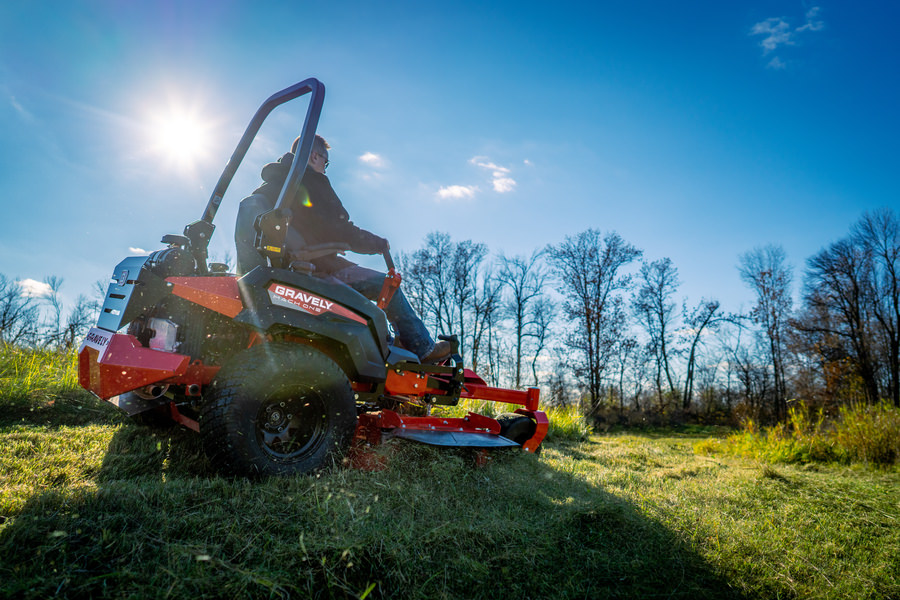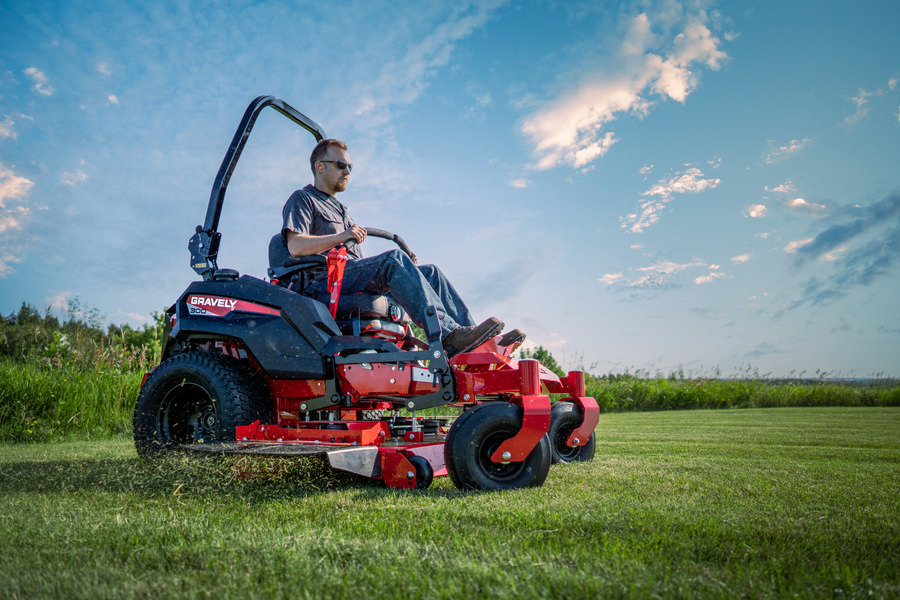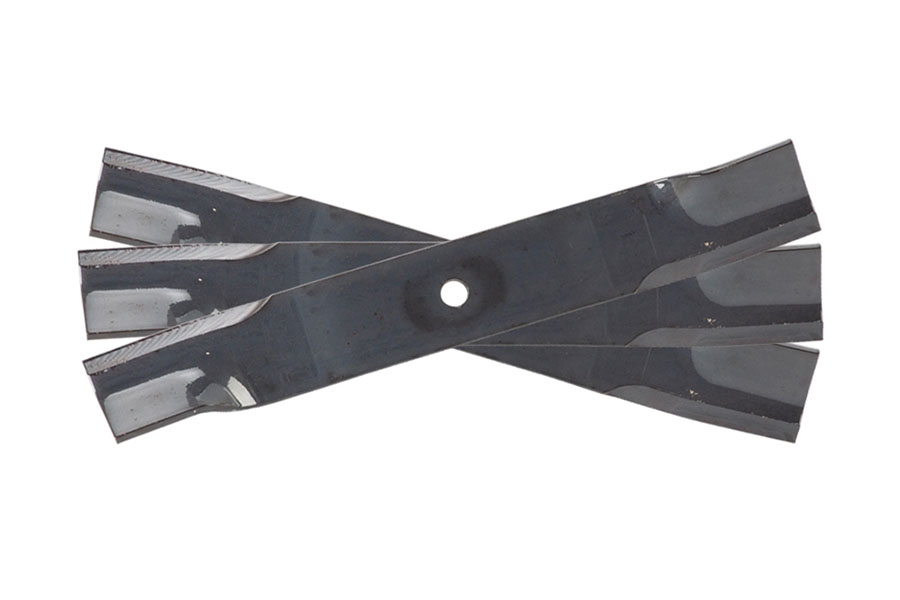Working in Challenging Landscapes
Commercial landscapers and lawn maintenance professionals have several variables that make their jobs difficult and physically demanding. Working in the outdoors means uncontrolled climates and landscapes can take control, leaving landscapers at the mercy of Mother Nature. Though she's still in charge, there are several ways landscapers can get around her challenges.

Read our tips to help tackle mowing in different types of weather and abrasive soils on the job site.
Weather
Mother Nature is our landlord. She has all the power over the landscaping industry and controls the conditions contractors work in – hot, dry, wet, bright and dark. For warm-season grasses, hot temperatures may be good for lawns, but too much heat can put a strain on the professionals.
Mowing Grass in The Heat
Ambient temperatures are hot enough during the summer. Add humidity and the heat index can rise to levels that cause dizziness or even heatstroke – especially for landscapers wearing workwear covering most of their body.
When working in high heat, the human body's natural response is to sweat, which cools down the body. However, sweating in these conditions causes fluid loss and requires frequent replenishment.
How much do we sweat?
According to active.com, the average person sweats between 27 and 47 ounces per hour during exercise. To put that into perspective, that's anywhere from one to two full, large water bottles. Though landscapers aren't jogging while cutting, it shows how much the human body can sweat and draws attention for the need to hydrate. Conditions can worsen mowing grass when hot and dry. It is important to keep your body cool and wear the proper clothing to prevent a heat stroke or dizziness.
Follow these tips when working in the heat.
Tips for working in the heat
- Hydrate
Those working outdoors need the most amount of water when working in direct sunlight, during peak energy exertion, and during the hottest part of the day.
- Clothing for working outdoors
- Shade yourself from the sun
Some lawn mowers include sunshade kit accessories that also help protect yourself from the sun.
- Adjust your work activity
Additionally, think about working at night. This comes with challenges, but Gravely helps make it possible by offering LED light kits that can be installed to any Gravely commercial lawn mower.
.jpg)
Mowing in The Rain
In wet seasons you can try to wait for the weather to clear up, but sometimes there's no way around it. Wet grass is heavier, leaves a clumpy discharge, cuts poorly, and makes the lawn mower engine work harder.
Wet grass not only leads to more buildup underneath your mower deck, which disrupts your cut quality, but it leaves unsightly clumps that cover the lawn. If neglected, those clumps can block sunlight long enough and kill the grass underneath.
If you have no choice but to mow in the rain, follow these tips:
-
Make sure your blades are sharp so you can minimize the tearing that can happen more easily in wet grass.
-
Set your mower's cutting height to a higher setting and cut half rows to keep the cutting deck from trying to process too much grass. This will put less strain on your deck and engine.
-
Always discharge wet grass clippings; never attempt to mulch or bag wet grass.
If you can afford the time, take breaks with each lawn to stop the mower and safely clean debris out from under the mower deck. Removing grass buildup from the deck and the blades allows the deck's aerodynamics to work as designed and provide good cut quality. If you can't clean the deck during breaks on the jobsite, do it at the end of the day.
Soil
Why does soil matter when cutting grass?
Certain soils in the southernmost parts of the U.S have sandier soils. Aside from having little nutrient value and reduced ability to retain moisture, sandy soils can be problematic for professional landscapers and their equipment.
Problems with sand
When mowing sandy soils the airflow generated by mower decks kicks up the sand and circulates it around the mower blades and the deck. This turns your zero turn mower into a sandblaster.
The abrasive nature of sand, compared to clay or silt soils, wears mower blades fast. It's so bad for landscapers in these areas that they'll sharpen or replace blades weekly, costing them time and money.
What to do?
First and foremost, it's important for commercial cutters to check their blades daily. For those not mowing in highly concentrated sandy soil areas, these soils can be surprisingly abrasive, causing blades to dull sooner than expected.
When blades become dull and rounded, they cut less effectively and can lead to the need to double-cut, costing more time and money. If the issue is ignored completely and blades go without sharpening or replacement for too long many problems can arise. These problems include:
-
Leaving grass stressed
-
Grass can become discolored
-
Grass becomes more susceptible to disease
The conventional approach to working in more abrasive soils is to sharpen or replace blades often, but this costs more downtime and money. To help avoid the hassle and the expense, landscapers can install LaserEdge® blades on their mowers.
The best lawn mower blades
Fisher Barton's LaserEdge blades debuted at the 2018 GIE+Expo in Louisville as a solution designed specifically for commercial landscapers working in sandy soil areas. LaserEdge blades use EverSharp™ technology, which is a reinforced bottom layer on the cutting edges of the blade that wears at a slower rate than conventional blade material.

As the top layer (conventional material) wears away, the bottom layer remains, creating a new cutting edge. These self-sharpening blades are extremely effective. They've been tested and proved to last for up to 50 hours, which is nearly five times longer than conventional blades in the harshest cutting conditions.
To see how LaserEdge blades can save time and money, ask for them from your local Gravely dealer or click here to purchase them online.
